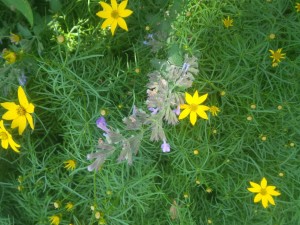We are now entering the daisy days of early summer, when Shasta daisies, coneflowers, Gaillardia daisies and a constellation of other Asteraceae or Compositae family members burst into bloom. I love them all, because they are strong growers, attract loads of butterflies and other pollinators, and are equally useful for ornamenting the garden or filling vases in the house. Whether your daisies are residing in a repurposed pair of old garden boots and ornamenting a miniscule balcony, or installed in a multi-acre parterre by your pricey private gardener, they will thrive. If your sunny garden situation lies somewhere in between those two extremes, daisy family members will undoubtedly fit right in. They are great equalizers.
Daisies are also eminently congenial garden dwellers and socialize well with members of other plant families. One of the best daisy/non-daisy pairings that I have found is a daisy/mint combo that requires almost no care, offers contrasting textures, blooms repeatedly throughout the summer and discourages garden varmints. This match made in horticultural heaven combines Coreopsis verticillata or threadleaf coreopsis, and Nepeta recemosa or catmint.
In the last twenty years or so, breeders have introduced any number of new coreopsis, sometimes known as “tickseed”. New and not-so-new varieties bloom in shades of yellow, red, peach, near-white and combinations of those colors. Many, but not all, are great garden plants.
I will always try something new, but for my money, the best coreopsis—and the one I pair with catmint—is Coreopsis verticillata ‘Zagreb’.
‘Zagreb’ is descended from a North American native species and has been in commerce for long enough to have proven its merit. It grows about 18 inches tall, with delicate, thread-like foliage and a mounding habit. The real stars of the ‘Zagreb’ show are the bright golden, daisy flowers, which are about three quarters of an inch wide and appear in very loose clusters. Blooming in great profusion several times during the growing season, ‘Zagreb’ is true to its starry family and lifts its surroundings. The growth habit also discourages weeds, a plus for lazy or time-challenged gardeners like me.
I pair ‘Zagreb’ with a blue-purple catmint variety that blooms at the same time and goes by the Latin name Nepeta racemosa ‘Walker’s Low’. Its friends call it ‘Walker’s Low’ catmint. Though “low” might suggest otherwise, at 30 inches tall, it does not grow particularly close to the ground. A card-carrying member of the mint or Labiateae family, catmint features stems that are square in cross section, as well as pungently aromatic leaves in a shade of gray-green. Its flowerheads are composed of scores of tiny, lipped flowers, which also carry the characteristic fragrance.
Though she is an old lady of 17, my cat, Sarah, will descend the back staircase on a sunny day just to plunge her face into the catmint clump that grows at its base. Afterwards she returns to her throne on the back porch to loll in a contented haze for an hour or so.
‘Walker’s Low’ is not the only catmint game in town. You might easily pair ‘Zagreb’ with the taller ‘Six Hills Giant’, which sports darker blue-purple flowers. If you decide on that combination, it is best to position the coreopsis in front of the catmint to show both plants to advantage. If you want a catmint that is shorter than the coreopsis, or you are trying to fit both in a large container, try Nepeta faassenii ‘Cat’s Meow’, which tops out at 17 to 20 inches tall.
I love blue and yellow combinations; each shade makes the other sing. If you have the space, alternate clumps of coreopsis and catmint for a lovely border.
The advantages of the pairing go beyond beauty. Mint family members deter rodents and varmints of all kinds. I have not known our perpetually ravenous deer herd to touch coreopsis either, but the presence of the catmint will further deter any four-legged marauder that acquires a strange taste for daisies. Both plants can also be easily divided to make more specimens, which is especially useful if you are trying to fill up a large garden space. Maintenance is easy and uniform for both species. After the petals drop, simply cut back the coreopsis and catmint by about one third to stimulate tidy appearance and rebloom. If you want to be thrifty and help repel plant predators naturally, collect the clippings and sprinkle them near more vulnerable species, like lilies, hostas, impatiens and sedum. Even dried out, the catmint retains its aromatic qualities.
I am an incorrigible plant collector and am almost always game for the new and different in the horticultural world. However, as in the case of blue-flowered “cats” and yellow-flowered “stars”, sometimes tried and true plant combinations are the best solutions to garden challenges.

